History
The first recorded bridge over the Golden Horn in Istanbul was built during the reign of Justinian the Great in the 6th century, close to the area near the Theodosian Land Walls at the western end of the city.
In 1453, during the Fall of Constantinople, the Turks assembled a mobile bridge by placing their ships side by side across the water, so that their troops could move from one side of the Golden Horn to the other.
In the years 1502–1503 there were plans to construct the first bridge at the current location. Sultan Bayezid II solicited a design and Leonardo da Vinci, utilizing three well-known geometrical principles, the pressed-bow, parabolic curve and keystone arch, created an unprecedented single span 240 m long and 24 m wide bridge for the Golden Horn, which would have become the longest bridge in the world of that time if it had been constructed. However, the ambitious design was not approved by the Sultan.
A smaller scale version of Leonardo da Vinci’s Golden Horn Bridge was brought to life in 2001 near Oslo, Norway by the contemporary artist Vebjørn Sand, the first civil engineering project based on a Leonardo da Vinci sketch to be constructed. The Leonardo Bridge Project hopes to build the design as a practical footbridge around the world, including the Golden Horn in Istanbul, using local materials and collaborating with local artisans as a global public art project. The Wall Street Journal referred to the Project as a “…logo for the nations.
Another Italian artist, Michelangelo was also invited to design a bridge for Istanbul. Michelangelo rejected the proposal, and the idea of building a bridge across the Golden Horn was shelved until the 19th century.
In the early 19th century Mahmud II (1808–1839) had a bridge built a bit further up the waterway, between Azapkapı and Unkapanı. This bridge, known as the Hayratiye (Benefaction in English), was opened on September 3, 1836. The project was carried out by Deputy Lord High Admiral Fevzi Ahmet Paşa using the workers and facilities of the naval arsenal. According to the History of Lutfi, this bridge was built on linked pontoons and was around 500 to 540 m long.
The first Galata Bridge at the mouth of the waterway was constructed in 1845 by Valide Sultan, the mother of Sultan Abdülmecid (1839–1861) and used for 18 years. It was known as the Cisr-i Cedid or New Bridge to distinguish it from the earlier bridge further up the Golden Horn, which became known as the Cisr-i Atik or Old Bridge.
On the Karaköy side of the bridge, there was an inscription as a couplet by poet İbrahim Şinasi saying that the New Bridge was built by Sultan Abdülmecid I. First to pass over the bridge was Sultan Abdülmecid, and the first to pass below it was the French captain Magnan in his ship the Cygne.
The second bridge
This bridge was replaced by a second wooden bridge in 1863, built by Ethem Pertev Paşa on the orders of Sultan Abdülaziz (1861–1876) during the infrastructure improvement works prior to the visit of Napoleon III to Istanbul.
The third bridge
In 1870 a contract was signed with a French company, Forges et Chantiers de la Mediteranée for construction of a third bridge, but the outbreak of war between France and Germany delayed the project, which was given instead to a British firm G. Wells in 1872. This bridge, completed in 1875, was 480 m long and 14 m wide and rested on 24 pontoons. It was built at a cost of 105,000 gold liras. This was used until 1912, when it was pulled upstream to replace the now genuinely old Cisr-i Atik Bridge.
The fourth bridge
The fourth Galata Bridge was built in 1912 by the German firm Hüttenwerk Oberhausen AG for 350,000 gold liras. This floating bridge was 466 m long and 25 m wide. It is the bridge, still familiar to many people today, that was badly damaged in a fire in 1992 and towed up the Golden Horn to make way for the modern bridge now in use.
The fifth (current) bridge
The fifth Galata bridge was built by the Turkish construction company STFA just a few meters away from the previous bridge, between Karaköy and Eminönü, and completed in December 1994. It was designed and supervised by GAMB (Göncer Ayalp Engineering Company). It is a bascule bridge, which is 490 m long with a main span of 80 m. The deck of the bridge is 42 m wide and has three vehicular lanes and one walkway in each direction. It has also recently had tram tracks re-added to it, allowing the Istanbul Tram to run from Zeytinburnu in the suburbs near Atatürk International Airport to Kabataş, a few blocks before Dolmabahçe Palace. This bridge along with Trowse Bridge in Norwich, Erasmus Bridge in Rotterdam, a number of bridges in Saint Petersburg in Russia, a number of railway bridges in the United States may be the only movable bridges in the world that also carry electrified rail tracks.
The rest of the bridge including the market area in the first floor opened to common use in 2003.
Culture
The Galata Bridge was a symbolic link between the traditional city of Istanbul proper, site of the imperial palace and principal religious and secular institutions of the empire, and the districts of Galata, Beyoğlu, Şişli and Harbiye where a large proportion of the inhabitants were non-Muslims and where foreign merchants and diplomats lived and worked. In this respect the bridge bonded these two distinctive cultures. As Peyami Safa wrote in his novel, Fatih-Harbiye, a person who went from Fatih to Harbiye via the bridge set foot in a different civilization and different culture. Apart from its place in fiction, the romantic appearance of the Galata Bridge made it the subject of many paintings and engravings.
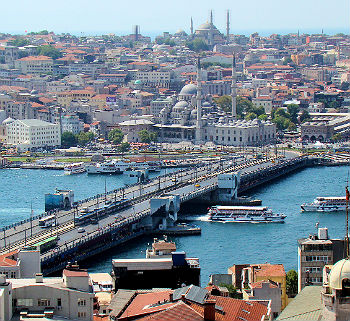
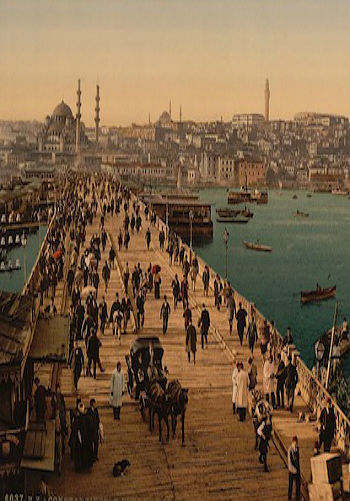
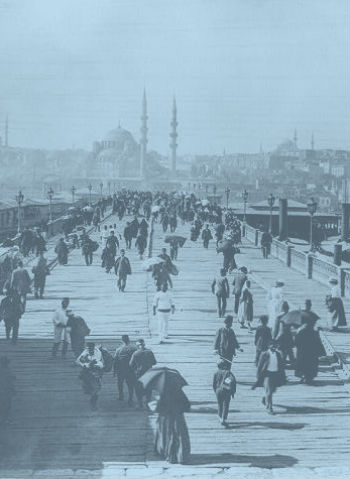
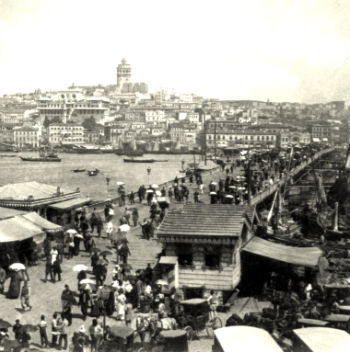
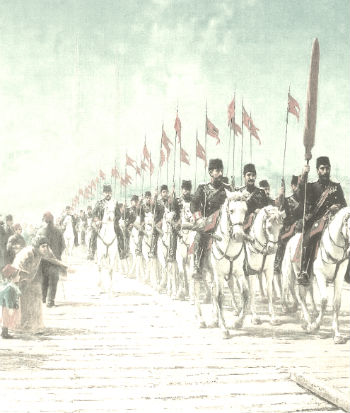
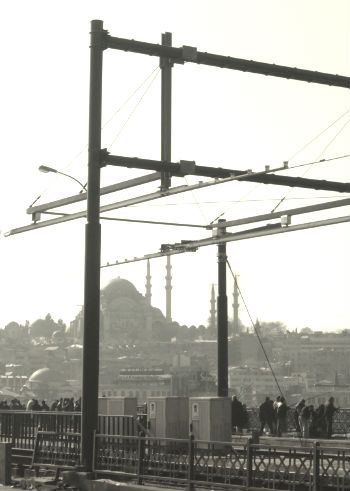
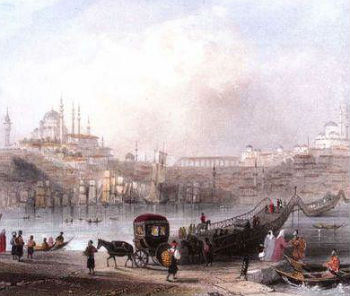


Walk along the underpass but be prepared to be hassled by the Restauranteurs who will be REALLY persuasive for you to come in and sample their seafood. Manyh excellent restaurants, but dont just go into the first you see. All ranges of food…. both in price & setting
The Galata Bridge is a great place to walk on the top and the bottom of the bridge. On the top is always filled with fisherman and the bottom you have lots of restaurants that sell you a variety of fish dishes. On the left side of the bridge you can have the famous fish sandwiches, they are good..
It's nice to see so many people fishing.Great view,especially if you come at night and sit on the beginning of the bridge so that you can see a luminous Bosporus bridge(I recommend you a bar with nargila for the perfect atmosphere).
Galata is an old and beautiful bridge. It is famous for walk and fishing. You will find people walking on the bridge and fishermen shoulder to shoulder catching fishes. Underneath the bridge there are some restaurants serving the famous fish sandwiches.
Walking The Galata Bridge is a colourful experience, so many people fishing, or selling an array of stuff. The traffic is unbridled. The bridge connects The Golden Horn district to Old Istanbul. Under the bridge are many restaurants.
To visit the Galata bridge for lunch or dinner is for many visitors a must. So it was also for me and my wife (who had been to Istanbul twice before). Its definately not worth the effort or the money. The restaurants are fake and have invented some kid of fantasy – price.
If you want to have a great time while enjoying fish for dinner, give the Galata bridge a skip and head to Kumkapi.
Walked over the bridge on a very busy Easter Sunday. The bridge was throbbing.
Went over the bridge, on the upper level, viewing the fisherman. Returned on the lower level thus running the gauntlet of the many restaurant staff encouraging us to patronise their establishments.
A must whilst in the City.
My travel companion and I got up early and walked to Galata Bridge to see sunrise on Istanbul. What a treat to look over Istanbul from this spot as the sun rises.
The bridge and surrounding areas are a beehive of activity. Fishing off the bridge, vendors, food stands, boats, travelers and commuters literally flood this area. Nothing specific to see, but there's so much activity.